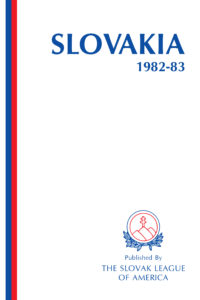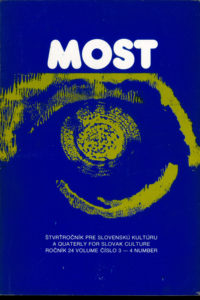About the Project
Words of Passage focuses on publications from the 1950s, 1960s, 1970s, and 1980s. Due to limitations on free press imposed by the ruling Communist Party on post-war Czechoslovakia, these cultural, literary, and scholarly works could not have been published domestically. Creative writers, historians, theologians, and other scholars fled Slovakia and turned to friendly foreign presses for outlets of creative works and scholarship. The writers of these journal publications trace the lineage of the Slovak people, document historical events, publish stories and poems, review books, study the Slovak language and linguistics, and argue the case for Slovaks’ centuries-long desire to become a self-governing people with Slovakia as a free and independent democratic republic.
In the 1880s, 1890s, and early 1900s, millions of immigrants arrived in the U.S. from central and eastern Europe, including hundreds of thousands of ethnic Slovaks, fleeing crop failure, land and job shortages, rising taxes, and famine. After working for a few years, many made the dangerous trip home with their newfound earnings to provide for their families back in Europe. Some even made the journey more than once. This round-trip phenomenon gave rise to the label “birds of passage.”
In the late 1940s, after World War II and particularly after the Communist Party coup of 1948, Slovaks once again fled by the thousands to the U.S. and Canada, as well as to places like Rome and Buenos Aires. This wave of emigration included scholars, writers, ordained men and women from Catholic religious orders, and political figures. Tens of thousands more fled after the Soviet-led Warsaw Pact invasion in 1968 following a brief period of political liberalization. With the suppression of free speech and government-run printing under Communist Party rule in Czechoslovakia, Slovaks living abroad could write and publish freely, but these words could not “return home” until the end of Communist Party rule, leading to the “Velvet Revolution” of 1989 and the “Velvet Divorce” of 1993.
The phrase “words of passage” is a play on the older label “birds of passage” as an acknowledgement to how, thirty years after the establishment of an independent Slovak Republic, scanning these important publications and making them freely available on the internet allows these collected works to “return home.”
As of March 1, 2023, over 10,000 pages have been scanned, processed, and posted. The first 25 volumes of the quarterly Most (1954-1978) are now available at the issue-level (such that each published issue is available as a PDF document). Additionally, tables of contents have been aggregated. Article-level indexing is underway. The project goal is to add eight additional years, making the full run of the journal as a U.S. publication under the editorship of founding editor Mikuláš Šprinc available online.
The first 30 volumes of Slovakia (1951-1983) are available online at the article-level, spanning the editorships of Philip A. Hrobak, Jozef Paučo, and Michael Novak. Metadata records use authorized forms of author names, allowing for a complete author index of the more than 600 articles. The project goal is to complete the journal run through its final publication in 2021.
Preliminary work for a third series title is underway.
Due diligence has been conducted on researching the copyright status of works made available online as part of the Words of Passage project. Every reasonable effort is made to ensure that the materials posted are done so in compliance with U.S. copyright law and do not unlawfully infringe on the rights of others. If you hold the rights to material that was made available online as part of the Words of Passage project and object to its posting, please contact the project director, Paul Soderdahl, by email at p-soderdahl@outlook.com.
Work is proceeding in close communication with the publishers (or their successor organizations), The Slovak League of America and Slovak Institute. Many of the earliest issues are in the public domain because they were published without notice, copyright is expired, or copyright was not renewed. In some cases, copyright status may be ambiguous, rights may have been transferred without written records or records have been lost or destroyed, or copyright succession may be impossible to determine, leaving the work as an orphan work.
Most importantly, however, these works were published trying to reach an audience as far and wide as possible. The creators of these works were not profiting from their proceeds. Print copies were sold to cover production costs, and there is no outlet at present for someone who even wishes to buy them. Absent digitization, these publications would remain locked up in closed archives, minimally cataloged and poorly indexed, where the words would go unnoticed and unread. By reproducing them digitally, the creators of these works are finally able to have the readership among native Slovaks that they could only dream of. Their words are given new life, allowing these creators to be impactful on 21st century Slovakia, a prospect that most of the authors never lived long enough to imagine would come to pass.
Note that unless stated otherwise, no representation is made about a work’s copyright status or your ability to download, reuse, or republish. Under U.S. copyright law and the fair use doctrine, each use must be independently considered determining for each factor whether it weighs in favor of or against fair use. As stated before, many of the items are already in the public domain. Additionally, effort is underway to attach a Creative Commons license to the works that may still be under copyright.
For the time being, Slovakia and Most are being made available online using the Omeka publishing platform. While designed for media-rich online exhibits, Omeka can be repurposed for electronic journals and other digital library applications. Omeka was chosen because of its low barrier to entry: a low annual fee and templates ready for use. Omeka is also used by many libraries and archives for cultural heritage collections, including the NCSML Digital Library, reducing the need for additional training and setting the stage for future integrations.
Omeka, however, is not a digital preservation platform and is a risky proposition for ensuring long-term preservation and access. The goal of the Words of Passage project is to enable universal access to significant scholarly and literary works currently tucked away on shelves in scattered libraries and archives. In the digital preservation community, there is a long-standing project initially from Stanford University playfully named LOCKSS, an acronym for “lots of copies keep stuff safe.” The long-term preservation and access plan for works digitized as part of the Words of Passage project is to find “lots” of repositories willing to curate the high-resolution source files as well as derivative access files.
The foundational strategy for long-term preservation and access is the Internet Archive. The Internet Archive’s library currently contains over 40 million books and texts, and all volumes of Most are being uploaded into an Internet Archive collection when they are ready for distribution. See https://archive.org/details/mostmagazine. Indeed, the issues of Most found on the Omeka site at https://most.omeka.net draw from the copies at Internet Archive and are viewed through an embedded Internet Archive BookReader displayer. If you are interested in curating a copy of the source files in your own digital repository, please contact the Words of Passage project director, Paul Soderdahl, at p-soderdahl@outlook.com.
Slovakia
Slovakia was an English-language scholarly journal published by The Slovak League of America from 1951 through 2021.
The scholarly annual Slovakia was published by the Slovak League of America from 1951 through 2021.
Slovakia was initially edited by Philip A. Hrobak, the editor of the weekly Jednota. After his death in 1964 Jozef Paučo, the former editor of the daily Slovák in Slovakia (1939-1945) took over until his death in 1975. After that the late Michael Novak edited it until 1982, when M. Mark Stolarik took over. He edited it through 2021.
Since the 1980s, Slovakia has served as the only English-language scholarly annual devoted exclusively to Slovak history.
This online republication of the journal is a work in progress. Special thanks to Slovakia‘s most recent editor M. Mark Stolarik and to Daniel F. Tanzone, president of the Slovak League of America, for their support and encouragement.
Thanks also to the staff at the National Czech & Slovak Museum & Library, Cedar Rapids, Iowa, and especially to David Muhlena, Library Director, and Cecilia Rokusek, President and CEO, for their support of this project. Most of the scans come from NCSML’s print holdings of the journal.
Most
Most: Štvrťročník pre slovenskú kultúru was a Slovak-language cultural-literary quarterly first published in 1954, with Mikuláš Šprinc as editor until 1986.
Most: Štvrťročník pre slovenskú kultúru was a Slovak-language cultural-literary quarterly founded in Cleveland in 1954 by Roman Catholic Slovak poet, essayist, writer, and translator Mikuláš Šprinc (1914-1986), with support from Rev. Ján Lach. Šprinc had been instrumental in building and fostering a network of the Slovak Roman Catholic intelligentsia who fled Slovakia after World War II. Together with Andrej Žarnov (1903-1982), Šprinc established the Association of Slovak Writers and Artists Abroad. Šprinc, with the help of Karol Strmeň (1921-1994), served as editor of Most from 1954 until his death in 1986.
Buried inside Most is a treasure trove of literary and cultural works by the post-World War II Slovak diaspora. Peter Cabadaj, Catholic modernism scholar, writes:
«Z historického zreteľa predstavuje Most nielen dôležitý pramenno-doku mentačný materiál, ale aj jedinečné svedectvo o tvorivých vzopätiach slo venského exilu. Ide nesporne o naše najvýznamnejšiea najreprezentačnejšie kultúrno-spoločenské periodikum v zahraničí…»
“From a historical point of view, Most is not only an important source and documentation material, but also a unique testimony of the creative upheavals of the Slovak exile. It is undoubtedly our most important and representative cultural and social periodical abroad…”
Cabadaj, Peter. Literárný Slovenský Exil: 1939-1990. Matica Slovenská, 2002. p. 50.
Most was digitized from the combined print holdings of the National Czech & Slovak Museum & Library and Indiana University Libraries.
Special thanks to the staff at the National Czech & Slovak Museum & Library, Cedar Rapids, Iowa, USA, and especially to David Muhlena, Library Director, and Cecilia Rokusek, President and CEO, for their support. Thanks also to the interlibrary loan staff at the University of Iowa Libraries, especially ILL supervisor Pat Baird.

